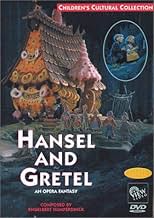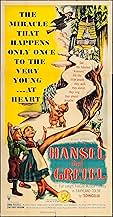AVALIAÇÃO DA IMDb
6,4/10
298
SUA AVALIAÇÃO
Adicionar um enredo no seu idiomaAn "electronic puppet" version of the Humperdinck opera, adapted for children and using spoken dialogue as well as Humperdinck's music.An "electronic puppet" version of the Humperdinck opera, adapted for children and using spoken dialogue as well as Humperdinck's music.An "electronic puppet" version of the Humperdinck opera, adapted for children and using spoken dialogue as well as Humperdinck's music.
- Direção
- Roteiristas
- Artistas
- Prêmios
- 1 vitória e 1 indicação no total
Anna Russell
- Rosina Rubylips - the Witch
- (narração)
Mildred Dunnock
- Mother
- (narração)
Frank Rogier
- Father
- (narração)
Delbert Anderson
- Sandman
- (narração)
Helen Boatwright
- Dew Fairy
- (narração)
- (as Helen Boatright)
Constance Brigham
- Hansel
- (narração)
- …
- Direção
- Roteiristas
- Elenco e equipe completos
- Produção, bilheteria e muito mais no IMDbPro
Avaliações em destaque
I found the other comments to be enlightening, especially with regard to the hurry-up conclusion.
However, I know for a fact that the boys' choir used in this movie was no a European choir, but the Apollo Boys Choir, originally of Palm Beach, Florida, that moved to Dallas, Texas until its director, Coleman Cooper, retired. It is unfortunately no longer in operation. During the Depression, the choir toured the United States in limousines, not buses, and sang for President Roosevelt at the Hot Springs resort where he escaped the pressures of Washington DC. The choir accompanist, Mr. Bert Hallack, is a resident of Palm Beach.
One famous former chorister of this choir is George Bragg, who founded the Texas Boys Boys (of Fort Worth).
However, I know for a fact that the boys' choir used in this movie was no a European choir, but the Apollo Boys Choir, originally of Palm Beach, Florida, that moved to Dallas, Texas until its director, Coleman Cooper, retired. It is unfortunately no longer in operation. During the Depression, the choir toured the United States in limousines, not buses, and sang for President Roosevelt at the Hot Springs resort where he escaped the pressures of Washington DC. The choir accompanist, Mr. Bert Hallack, is a resident of Palm Beach.
One famous former chorister of this choir is George Bragg, who founded the Texas Boys Boys (of Fort Worth).
Although this film may look like it was from Eastern Europe, it was definitely made in New York City. I was a member of the Apollo Boys Choir in 1953(we were from Palm Beach, Florida), and I remember visiting the studio in New York while the film was being shot. We came up from Palm Beach in the fall to record our part of the sound track. The choir director, Coleman Cooper, was a perfectionist, and we worked harder on this music than any other set of pieces I can remember. Unfortunately, by the time we got to New York we were pretty sung out. The recording session was long, and during it the producer decided that our sound needed some bolstering, so he brought in several female members of the Metropolitan Opera Chorus to help out. Mr. Cooper must have been very disappointed. This was an important project for him. We boys were a little disappointed too. I, at least, quickly got over it. The women, of course, were excellent singers, several were quite attractive, and they thought we were cute.
This is a stop-motion animation film of the Hansel and Gretel fairy tale, done, apparently, somewhere in Europe--the Austrian Apollo Boys Choir does the background vocals, so the film could have been made there or in nearby Hungary or Czechoslovakia, both of which were producing well-done animation films--but passed off as an American film, which it is not. Considering the time it was made and the conditions existing in Europe during that period, it is an admirable attempt indeed. The stop-motion, while not up to the standards of Ray Harryhausen, who was doing similar work at the time, is still well-done, and great care was obviously taken in the dubbing and scoring of the film. The background music is at times a bit overpowering, and there are spots where the dialogue is drowned out by it, but there are some imaginative touches throughout and and some visually beautiful moments. Children who are used to today's high-tech computer animation may not be impressed technically, but the film overall should appeal to them. Recommended.
Despite its European, "old world" look, Hansel and Gretel was made in New York City. Indeed the comments to the contrary are a tribute to the filmmakers' success in evoking a genuine fairy tale style. Nonetheless, the film was shot using conventional stop-motion puppets (notwithstanding the producer's claims to using some sort of mysterious "electronic" method) in the main room of an abandoned courthouse which is still standing at the corner of Second Avenue and Second Street in New York City. The large set was built in the main chamber on the second floor (now the largest of several theaters in what is currently (2005) the Anthology Film Archives).
Apparently electromagnets were used to hold the stop-motion puppets in place during some sequences, but normal procedures were used for the rest. This and some hype that lured in backers may account for the mistaken report that they are electronic puppets. They were solid, armature puppets and not clay (or "claymation") dolls.
The set survived the production and actually toured county fairs as a fairy tale exhibit for many years after the completion of the film.
Apparently electromagnets were used to hold the stop-motion puppets in place during some sequences, but normal procedures were used for the rest. This and some hype that lured in backers may account for the mistaken report that they are electronic puppets. They were solid, armature puppets and not clay (or "claymation") dolls.
The set survived the production and actually toured county fairs as a fairy tale exhibit for many years after the completion of the film.
This film has always been one of my top favorite childhood films. "Hansel and Gretel" was not always easily accessible to kids. Although it had sporadic television showings back in the days of black and white televisions, kids normally had to wait about every three years for it to be theatrically re-released to see it. I remember seeing it once on television back in the days before we had color television sets and then seeing it several years later on the big screen (in all of its Technicolor splendor) and it captivated me by being the definitive version of the famous tale. I liked it so much that when they re-released it some years later I went to see it again! After the mid-seventies it more or less disappeared and it seemed to have become a forgotten film (shown occasionally on early cable T.V.). However, in the early eighties I was surprised to see it on VHS through a company called Media Home Entertainment. Sadly, their print had a terrible mono soundtrack making the film inaudible and the scene where the the stars form in the heavens (after the Sandman floated away) looked like it was set in the daytime instead of at night-time. Later, in the eighties a no-frills video company released the same print with a marginally better soundtrack. When HBO showed it in the early nineties, they showed a restored quality print. One with perfect sound and with the stars in the heavens forming in the evening (keeping to the evening setting of Hansel and Gretel asleep under a tree in the forest). Not long afterward, that restored version was put on to VHS by Vestron and I was delighted. Too bad that Vestron didn't hold on to the rights long enough to put out a DVD edition of the film. It has since fallen into the hands of another company and they've evidently used a not exactly perfect VHS print of the film as the master source for their DVD presentation of "Hansel and Gretel". The evidence of VHS decay are sporadically obvious during the film. It's annoying that the company probably had the means to give us "the" perfectly restored version of the film on DVD, but instead decided to gyp us with a low-budget video to DVD transfer of it. I hope that another company will obtain the rights to this film and put a good copy of it on the market soon. "Hansel and Gretel" must have been a pretty big hit in its day (1954). There was a comic book and a record album of this film. I know that the two times that I saw it in the theaters it played to packed movie houses. Let's hope to see a restored DVD edition of it the near future!
Você sabia?
- CuriosidadesRe-released in 1972 as part of MGM's Children's Matinees package.
- ConexõesFeatured in Animation Lookback: The Best of Stop Motion - The First Features (2014)
Principais escolhas
Faça login para avaliar e ver a lista de recomendações personalizadas
Detalhes
- Tempo de duração1 hora 12 minutos
- Mixagem de som
Contribua para esta página
Sugerir uma alteração ou adicionar conteúdo ausente

Principal brecha
By what name was A Floresta Mágica (1954) officially released in Canada in English?
Responda



















